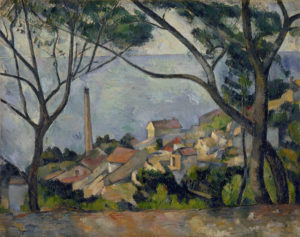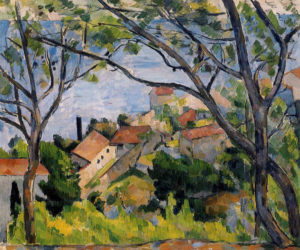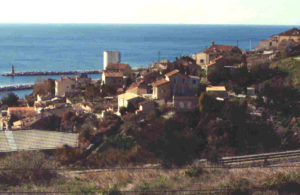R395 – La Mer à l’Estaque derrière les arbres, 1878-1879 (FWN120)
R396 – L’Estaque vu à travers les arbres, 1878-1879 (FWN121)
Pavel Machotka
(Cliquer sur l’image pour l’agrandir)
In La Mer à l’Estaque derrière les arbres, the irregular mosaic of houses which Cézanne painted more than once, is constrained by the framing trees; they point toward the upper left, to balance the roofs, which point toward the upper right. The branches are fluid in contrast to the scatter of houses, which are angular, and their improbable smoothness is the product of simplifying their sinewy shapes; these can be seen in an earlier and rougher version, which is more spontaneous and, in the trees, more realistic :
With this broad equilibrium in place, Cézanne is free to indulge in a spree of color, as vivid in the surface of the water as among the houses: in the bay he ranges not only from blues to greens, but also over pale violets and ochres, and among the houses he places earth tones, blue-greys, and a brilliant red which underscores the central, solitary house outlined against the water. Since the village of l’Estaque is quite irregular in the layout of its streets, the parallel touch alone could not possibly organize the views of its buildings; making a virtue of necessity, then, Cézanne kept the touches fully as irregular as the diffuse motif (except in the vegetation, where he set them down in a single direction), and based the organization and equilibrium of the painting on color instead.
Adapted from Pavel Machotka, Cézanne: The Eye and the Mind.
Voir aussi l’article de Geneviève Blanc : Retour sur deux motifs peints par Cezanne à L’Estaque.
Le site aujourd’hui :





Vous devez être connecté pour poster un commentaire.